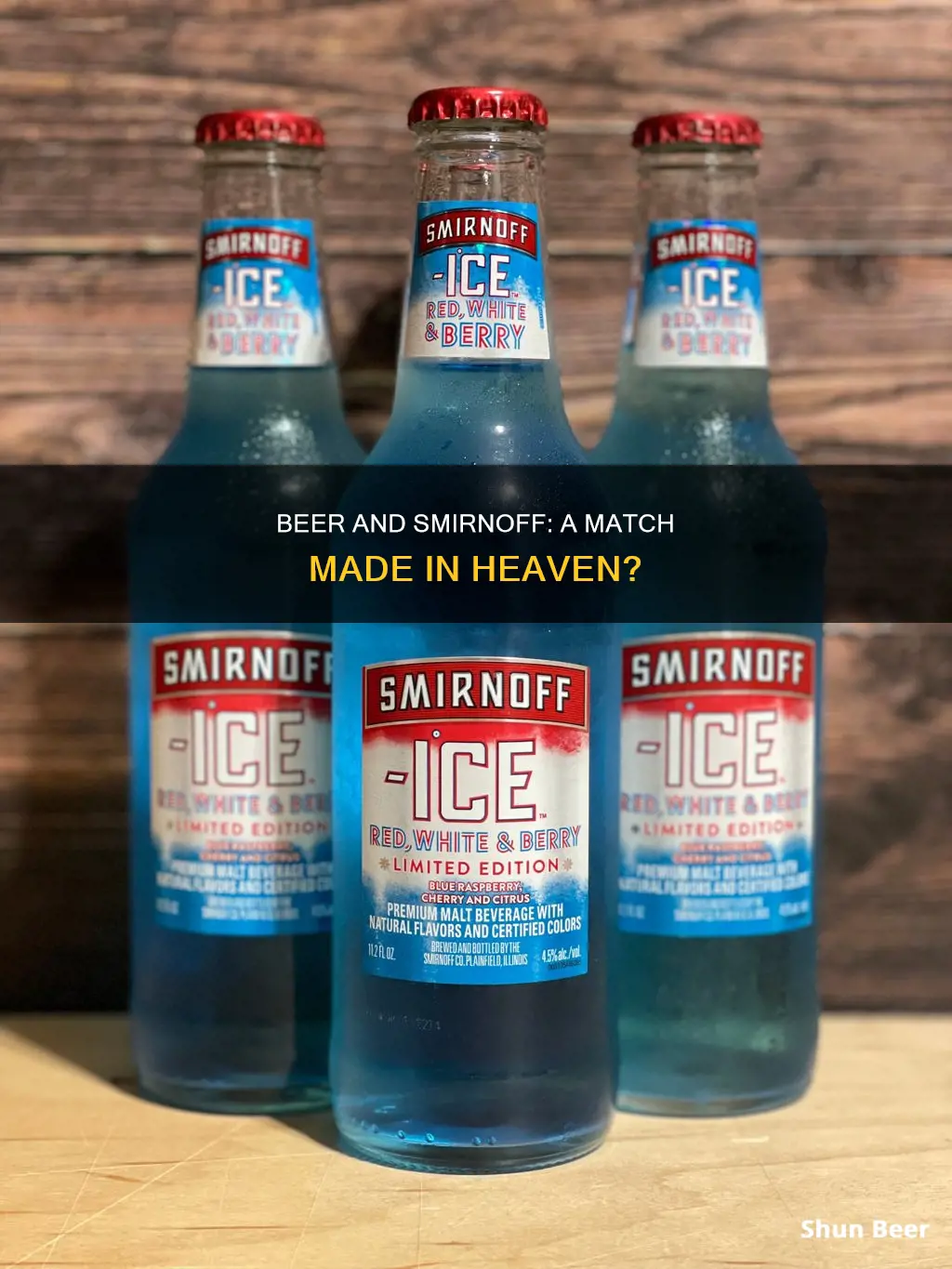
Smirnoff is a well-known vodka brand with a rich history that dates back to 1864 when its distillery was founded in Moscow, Russia. The brand has since expanded its product line to include various flavours and infusions, such as Smirnoff No. 21 Vodka, Smirnoff 90, and Smirnoff 100, as well as zero-sugar options. However, the question of whether one can drink beer and Smirnoff simultaneously is specifically referring to the product 'Smirnoff Ice'. Smirnoff Ice is a malt beverage that is brewed and fermented like beer, giving it an alcohol content similar to that of a standard beer. While it is considered a beer in the US, in other countries, it is spiked with additional alcohol, taking it out of the beer category. So, while you can certainly drink beer and Smirnoff Ice, the latter is more similar to beer than to the distilled vodka that the brand is famous for.
| Characteristics | Values |
|---|---|
| Smirnoff Product Type | Vodka, flavoured vodka, malt beverages |
| Smirnoff Vodka ABV | 35-50% |
| Smirnoff Ice ABV | 4.5% |
| Smirnoff Ice Ingredients | Malt, brewed with a malt base |
| Smirnoff Ice Classification (US) | Beer |
| Smirnoff Ice Classification (Other Countries) | Mixed drink or cocktail |
| Smirnoff Mule Classification | Vodka-based drink |
What You'll Learn

Smirnoff Ice: Beer or Not?
Smirnoff is a well-known vodka brand with a wide range of products, including flavoured vodka and malt beverages. But what about Smirnoff Ice? Is it considered a beer?
Well, that depends on where you are. In the United States, Smirnoff Ice is indeed classified as a beer. It is brewed with a malt base, fermented in the same way as beer, and has an alcohol by volume (ABV) percentage similar to that of domestic beers. So, if you're in the US and drinking Smirnoff Ice, you're essentially drinking a beer, even if it doesn't quite taste or look like one.
However, in other parts of the world, the story is different. In countries like Brazil, South Africa, Canada, England, and Ireland, Smirnoff Ice contains both vodka and malt. In these places, it is considered more of a mixed drink or cocktail rather than a beer. So, while it may be a beer alternative in the US, it's not quite the same story internationally.
It's worth noting that Smirnoff Ice is just one product line from the Smirnoff brand, and most of their other offerings are indeed vodka-based. So, while you might be drinking a beer when you choose Smirnoff Ice in certain countries, the brand is predominantly known for its vodka products.
So, the next time someone asks if Smirnoff is a beer, you can confidently answer that it's a bit of a mixed bag, depending on the specific product and where you are in the world.
Hopsy Beer: How Does the Freshness Work?
You may want to see also

Smirnoff's History
Smirnoff is a brand of vodka with a rich history that dates back to the 19th century. Here is a detailed account of the brand's fascinating journey:
The Early Years:
Pyotr Arsenievich Smirnov, also known as Pyotr Smirnov, founded the vodka distillery that would become the Smirnoff brand in Moscow, Russia, in 1864. Born a serf, Smirnov's journey is a true rags-to-riches story. He began selling his vodka in the same year, using innovative marketing techniques such as newspaper advertising and charitable donations to the clergy to suppress anti-vodka sermons. Smirnov even enlisted the help of panhandlers in Moscow, inviting them to his home for food and drink, and then sending them out to local bars to demand Smirnoff vodka, effectively boosting sales and establishing the brand in Russia.
Royal Recognition:
Smirnov's vodka was of superior quality due to his pioneering use of charcoal filtration, which made it purer than its competitors. By 1886, he had captured two-thirds of the Moscow market. His vodka even earned royal recognition, as he secured the exclusive contract to supply vodka to Tsar Aleksandr III Aleksandrovich of Russia. Russian royalty reportedly regarded Smirnov as a favourite.
Revolution and Exile:
Political unrest marked the early 20th century, with the October Revolution of 1917 forcing Smirnov's son, Vladimir, to flee Russia. Vladimir established a distillery in Constantinople (present-day Istanbul) in 1920 and later moved to Lviv (then in the Second Polish Republic, now Ukraine). It was during this time that the vodka's name was changed to "Smirnoff", adopting the French spelling due to the exile from Russia.
International Expansion:
In 1925, an additional distillery was founded in Paris, but sales were still a far cry from the brand's success in pre-revolutionary Russia. In the 1930s, Vladimir met Rudolph Kunett, a Russian émigré in New York, and sold him the rights to Smirnoff vodka production and sales in North America. However, the brand initially struggled to find success in the American market, as vodka was seen as an ethnic spirit.
Breakthrough in America:
The turning point for Smirnoff in the United States came when a South Carolina salesman began promoting it as "white whiskey – no smell, no taste". This repositioning resonated with American whiskey drinkers, and the brand gradually gained traction. In 1941, the Moscow Mule cocktail was invented, marking the first big cocktail breakthrough for Smirnoff. The brand's popularity continued to grow, especially with the baby-boom generation, and it received a further boost from its association with the James Bond films, starting with "Dr. No" in 1962.
Global Dominance:
Smirnoff continued to expand globally, investing in local production in key markets. By the mid-1970s, it had become America's top-selling spirit, and in 2003, it achieved the status of the world's largest premium vodka brand. Today, Smirnoff is distributed in over 130 countries and is the top-selling vodka worldwide, with sales of over 25 million nine-liter cases in 2019. The brand has since diversified its offerings, introducing various flavours and product lines, solidifying its position as a global leader in the spirits industry.
Beer Benefits for Hair: A Guide
You may want to see also

Vodka Varieties
Vodka is a distilled beverage composed primarily of water and ethanol, sometimes with traces of impurities and flavourings. Vodka is usually produced using grains such as wheat, rye, and corn, but it can also be made from potatoes, molasses, soybeans, grapes, rice, or sugar beets. The base ingredients give vodkas their distinct flavours.
The most popular vodka brand in the world is Smirnoff, with 26 million 9-litre cases sold in 2023. Other popular brands include Grey Goose, Absolut, and Ketel One. These brands are known for their smooth, neutral flavour that works well in cocktails.
- Chopin Vodka (Poland): Named after the famous Polish composer, this vodka is made from potatoes and goes through a quadruple distillation process. It's smooth and perfect for a cold evening by the fireplace.
- Ciroc Vodka (France): This French vodka is famous for its marketing by Sean "P. Diddy" Combs. It's distilled five times from grapes and has various flavoured varieties, including amaretto, coconut, peach, pineapple, and red berry.
- Kauffman Luxury Vintage Vodka (Russia): This vintage vodka is produced by a doctor who selects the best wheat from around Russia for his mash. It's distilled fourteen times and then filtered twice, resulting in a subtle and delicate flavour.
- Snow Queen Vodka (Kazakhstan): An organic wheat vodka distilled five times, resulting in a top-class spirit that can be drunk neat or in cocktails.
- Hangar 1 Vodka (America): This Californian vodka is made from Viognier grapes and Midwestern grains and is produced in an abandoned Navy hangar, giving it a unique style.
- Kubanskaya Vodka (Russia): A flavoured vodka with notes of lemon and orange.
- Pertsovka Vodka (Russia): A spicy vodka with peppercorns and chilli peppers.
- Żubrówka Vodka (Poland): A bison grass vodka with diverse notes of woodruff, coconut, and bison grass.
A Beginner's Guide to Joining a Beer Crawl
You may want to see also

Beer vs Vodka
Smirnoff is a brand of vodka owned by the British company Diageo. While vodka is a spirit, some Smirnoff products are malt beverages, similar to beer. However, the Smirnoff Ice marketed in the United States contains no vodka and is more similar to beer as it is brewed. Outside the US, Smirnoff Ice does contain vodka.
Beer and vodka are vastly different from one another in terms of both utility and origin. Beer is the oldest known alcoholic drink, dating back more than 3900 years to Ancient Mesopotamia. Vodka, on the other hand, originated in the mountains of Poland and Russia and was first mentioned in 1405.
Calories
Vodka has a lower calorie count than beer. A regular 12-ounce beer contains about 150 calories, while the same amount of vodka contains only 100 calories. A tallboy (64-ounce) beer contains about 260 calories, while a regular serving of vodka has only 80 calories. Vodka is, therefore, a better option for those looking to lose weight or watching their calorie intake.
Longevity
Vodka is distilled multiple times and has a higher alcohol content, making it easier to preserve. It can be stored in the freezer for longer periods without affecting the alcohol. Beer, on the other hand, usually has a specific expiry date spanning just a couple of years and can turn stale a day or two after opening.
Alternative Uses
Beer is typically only consumed as a drink, while vodka has various alternative uses. Vodka can be used for cooking, baking, and disinfecting wounds and surfaces. Its clear and transparent appearance make it ideal for use in salads, meats, and pasta dishes. Beer, on the other hand, can worsen infections if poured on an open wound.
Cardiovascular Health
Excessive beer consumption can negatively impact cardiovascular health. In contrast, vodka can improve heart health by reducing cholesterol levels and promoting good blood circulation. Studies have shown that drinking a shot of hard liquor each day reduces the risk of heart attacks and strokes by 10% to 15%. Vodka also increases good cholesterol and prevents blood platelets from clotting.
Weight Gain
Beer is associated with "beer bellies" due to its high-calorie content, which can result in fat accumulation around the gut. Beer also interferes with glucose levels, causing increased hunger and overeating. Vodka, on the other hand, has zero fat and is less likely to contribute to weight gain.
Seasonal Preferences
Beer is typically associated with being a cold-weather drink, while vodka is considered a year-round beverage. Vodka has a warming effect and can be mixed into warm drinks like Hot White Russian, Hot Honey Lemon, and Vodka Hot Chocolate. It can also help kick a fever, making it a popular choice during the cold weather season.
Beer and Motrin: Safe Mix or Health Risk?
You may want to see also

Smirnoff Cocktails
Smirnoff is a well-known vodka brand with a rich history dating back to 19th-century Russia. Over the years, the brand has expanded its offerings beyond traditional vodka, including flavoured vodka and malt beverages. One of the most popular ways to enjoy Smirnoff is in cocktails, and here are some of the most well-known and beloved Smirnoff cocktail recipes:
Smirnoff Espresso Martini: This is a modern classic and a perfect pick-me-up. It combines Smirnoff vodka with espresso, creating a delicious blend of coffee and vodka flavours.
Smirnoff Passionfruit Martini: A tropical twist on the classic martini, this cocktail blends Smirnoff vodka with passionfruit flavours, resulting in a refreshing and fruity drink.
Smirnoff Screwdriver: A simple yet effective cocktail, the screwdriver combines Smirnoff vodka with orange juice, creating a tangy and vibrant drink.
Smirnoff Bloody Mary: This classic cocktail is a savoury delight, blending Smirnoff vodka with tomato juice, lemon juice, and various spices. It's a perfect brunch cocktail.
Smirnoff Cosmopolitan: Popularised by its appearance in the TV show *Sex and the City*, the cosmopolitan is a vibrant, fruity cocktail made with Smirnoff vodka, cranberry juice, lime juice, and triple sec.
Smirnoff Green Apple Martini: A playful take on the classic martini, this cocktail combines Smirnoff vodka with green apple flavours, resulting in a crisp and refreshing drink.
Smirnoff Kissed Caramel Mule: This cocktail puts a delicious spin on the traditional Moscow Mule. It combines Smirnoff vodka with caramel flavours and ginger beer, creating a sweet and spicy drink.
Smirnoff Raspberry Lemonade: Perfect for a hot summer day, this cocktail blends Smirnoff vodka with raspberry and lemonade flavours, resulting in a refreshing and tangy drink.
Smirnoff Vanilla Dream: As its name suggests, this cocktail is a dream come true for vanilla lovers. It combines Smirnoff vodka with vanilla flavours, creating a smooth and indulgent drinking experience.
These are just a few examples of the many Smirnoff cocktails that can be crafted. Whether you're looking for a classic martini, a fruity twist, or a refreshing summer drink, Smirnoff vodka provides a versatile base for countless cocktail creations.
Pouring Beer: Understanding the Inner Workings of a Faucet
You may want to see also
Frequently asked questions
Smirnoff is a vodka brand, but it has produced a beer—of sorts. Smirnoff Ice is a malt beverage that is brewed and fermented like beer and has an ABV similar to that of a standard beer. In the US, it is officially categorised as a beer. However, in other countries, Smirnoff Ice contains vodka and is considered a mixed drink or cocktail.
It depends on the product. Smirnoff vodka typically has an ABV of 35-50%, which is higher than the ABV of common beer brands, which hover around 4.5-6.0% ABV. However, Smirnoff Ice has an ABV of 4.5%, which is similar to that of a standard domestic beer.
Smirnoff Ice is a line of malt beverages produced by the Smirnoff vodka company. It was launched in 1999 and quickly became popular at college parties and casual hangouts. Smirnoff Ice comes in various flavours, including Screwdriver, Pink Lemonade, Peach Mango, and Spicy Margarita.
Smirnoff Mule is predominantly a vodka drink. It is a mix of Smirnoff original vodka, ginger beer, and lime-flavoured water. It is similar to a Moscow Mule.
The unflavoured version of Smirnoff vodka is gluten-free as it is made from corn. However, the flavoured versions may contain trace amounts of gluten as they contain "natural flavourings".







